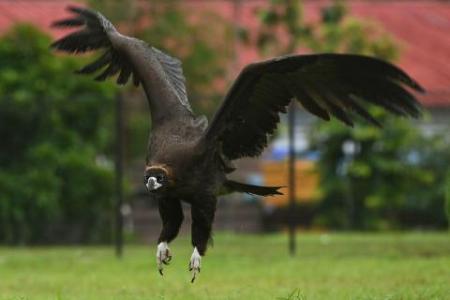Second attempt to free cinereous vulture fails with bird not being able to sustain flight
The rare cinereous vulture - the first of the species recorded in Singapore - tested its wings for the first time on Wednesday afternoon (Jan 5) since hospitalisation.
The clear sunny skies and winds made it optimal for the raptor to rise, with the National Parks Board (Nparks) deciding to free the bird just two hours before the time initially planned to ensure the best conditions for its release.
But the juvenile, which weighs about 7kg , barely flew about 50m away before landing in an adjacent field.
Following its short flight, the vulture was examined by veterinarians from Jurong Bird Park before it was allowed to try again. But it merely wandered for an hour. Weather conditions worsened and the bird was taken away by NParks and Mandai Wildlife Group staff to rest for the day.
Wednesday's attempted release of the juvenile follows another attempt the day before.
In a statement to The Straits Times on Monday night, Dr Xie Shangzhe, deputy vice-president for conservation, research and veterinary at Mandai Wildlife Group, said that the migratory bird had been assessed to be strong enough to fly sufficient distances and reach an area with food. This was among other criteria used to time its release, which includes weather conditions.
"It is necessary to make sure that these animals achieve good return-to function to ensure their survival back in the wild," he said.
"For migratory species, there is a fine line between releasing them too early, such that they have not built up enough energy reserves, and releasing too late, resulting in a disruption of their migratory movement patterns."
The cinereous vulture was first sighted at Singapore Botanic Gardens a week ago.
On Thursday, it was photographed by flocks of bird enthusiasts along with five Himalayan griffon vultures at the gardens.
It was later found sitting weakly on the ground at Cornwall Gardens by a bird photographer who wanted to be known as Martin T.
NParks group director of wildlife management Adrian Loo told The Straits Times on Tuesday that the cinereous vulture had taken off with other birds at Singapore Botanic Gardens in the late morning, but was too weak to sustain flight and landed.
Dr Xie said on Monday that the scavenger's weakened state was probably due to exhaustion from flying long distances - a common challenge faced by migratory birds - and it needed to replenish its energy reserves.
The bird was later taken to Jurong Bird Park's bird hospital for veterinary care until Monday.
No abnormalities or injuries were detected when the scavenger was first checked by Jurong Bird Park's avian veterinarian team, said Dr Xie.
The sooty species, native to Europe and northern Asia, is vagrant to South-east Asia, said Dr Loo. This means the bird has flown off-course or was blown off-course.
It usually spends winters in northern India, the Middle East and occasionally South Korea, he added.
"During the yearly migratory bird season, thousands of migratory birds fly in from their breeding grounds in the Northern Hemisphere to Singapore to feed and roost," said Dr Loo.
This occurs between September and March, and the nation's mangroves, mudflats, ponds and forests become homes for these birds.
Singapore is an important stopover for migratory birds, said Dr Loo, as it is part of the East Asian-Australasian Flyway - a migratory route that stretches from the Arctic, through Russia and Alaska to Australia and New Zealand, encompassing 22 countries - and the Central Asian Flyway, which includes the Himalayas, where the cinereous vulture can be found.
Wherever possible, migratory birds taken into Jurong Bird Park's bird hospital will be released back to their natural habitats, usually within a day if they are healthy, said Dr Xie.
There are rare instances, however, where a bird may be absorbed into Mandai Wildlife Group's parks if they require long-term care and monitoring, he added.
In 2005, a Himalayan griffon vulture was rescued at Nanyang Girls' High School after it was seen vomiting.
The scavenger, named Genghis, remains under the care of the park's Animal Presentation team after it was treated and rehabilitated.
Members of the public should contact NParks or the Animal Concerns Research and Education Society (Acres) when they encounter an injured bird or any animal requiring assistance.
They should not approach, provoke or feed the animal, and follow the instructions of the NParks or Acres officer on the phone. The public may contact NParks on 1800-471-7300 or Acres on 9783-7782.
Bird photographers, such as the crowd of about 50 enthusiasts seen taking photos of the vulture last Thursday, are also advised by NParks to be socially responsible and observe safe management measures.
Get The New Paper on your phone with the free TNP app. Download from the Apple App Store or Google Play Store now


